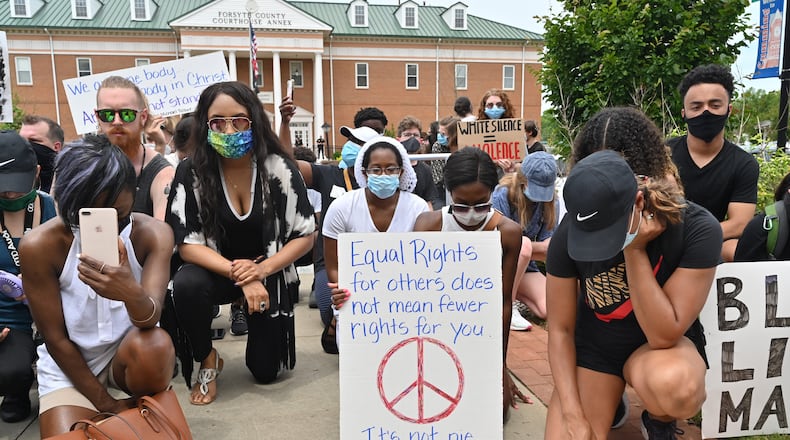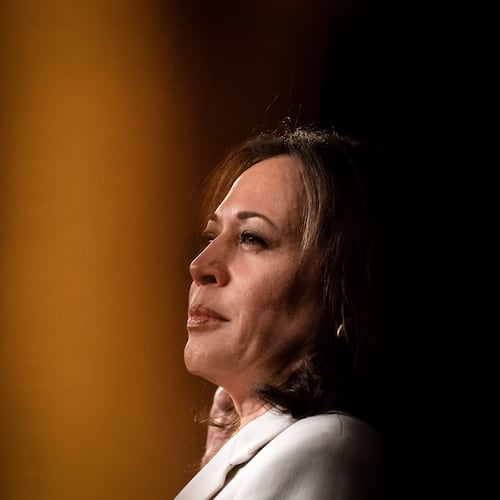It’s been 110 years since a white mob violently drove out James B. Nuckles’ family from Forsyth County. Some of his relatives migrated to Roswell and Atlanta. At least one resettled in Gwinnett. To this day, his family tree is missing many of its limbs.
“I’ve got relatives here in Buford I’ve never seen before,” Nuckles said Friday at a community gathering to discuss the racial cleansing in 1912 that forced the Black population of roughly 1,100 to flee Forsyth County.
There are new efforts underway to make sure the tragedy isn’t forgotten.
A historical marker commemorating victims now stands vigil in downtown Cumming. Benefactors just announced they’re offering $10,000 college scholarships to descendants of the exiled. A U.S. House resolution introduced by Georgia Democrats this month condemns the violence. The book “Blood at the Root” — a 2016 book by Patrick Phillips that investigated the Forsyth racial cleansing — continues to bring attention to the atrocity.
But there are growing fears among the descendants of the victims and their allies that some in the community would rather forget. And they worry the conservative furor over how race is taught in public schools will only complicate their efforts to bring more attention to the racial purge and its aftermath.
Latresha Jackson said she worries that backlash to critical race theory — graduate-level coursework not taught in Georgia public schools — will give administrators an excuse to block teaching about the “true history” of Forsyth County.
“We have parents banning books, we have people screaming about critical race theory missing the whole point of American history. All of that has been put on hold,” she said at Friday’s meeting, attended by a few dozen community leaders and volunteers. “It’s complete denial.”
A county official didn’t dispute that more plans to teach students starting in the eighth grade about the attacks have been postponed, though she added historians still plan on developing coursework.
The racial violence in 1912 was triggered by the murder of a white woman. A lynch mob attacked and hanged one suspect; later, two teenagers were executed in public after a speedy trial. Vigilantes terrorized Forsyth’s Black residents — then about 10% of the county’s population — and forced 1,098 to flee.
For decades, the county continued to have a reputation as a haven for hate to many Black Georgians. Several descendants of victims said at the meeting they grew up avoiding Forsyth County, warned by relatives haunted by the 1912 violence to steer clear of the area, especially after sundown.
A pair of civil rights marches in the late 1980s — the first included violent clashes with white supremacists — brought a torrent of national attention — and the first significant signs of change. About 4% of the county’s population is now Black, a small but growing number.
Many descendants of the victims are still in the dark about their heritage. Elon Osby’s mother was 2 when her family stuffed all the belongings they could fit into a wagon and left behind their 60-acre plot of land, now a pristine subdivision for up-and-coming families. She talks about what happened more than a few century ago every chance she gets, in part to inspire others to embrace their history.
“There’s some hesitancy about coming out, but we’ve got to get over it,” she said. “Every time we tell this story, someone new hears about it. If there’s a motto from me, it’s that we need to keep telling the story so that it doesn’t happen again.”
The gathering Friday was organized with the help of U.S. Rep. Carolyn Bourdeaux, who authored a resolution to condemn the racist violence, acknowledge its impact on the Black community national day of remembrance for victims of forced migrations. It was co-sponsored by every Democratic member of the Georgia House delegation.
“We need to have these conversations,” said Bourdeaux, who said she read “Blood on the Root” shortly after deciding to run for public office to better understand Forsyth County’s history. “People in the white community need to understand what happened.”
Osby said she understood why some Forsyth County leaders could be embarrassed to have their children taught about the shameful episode. But reckoning with the community’s past, she said, is the first step toward healing.
“This gives me hope,” said Osby, scanning the room of dozens of multiracial attendees, including a number of students. “I know that everyone in here will tell this story. And it gives me hope this won’t happen again.”
About the Author
The Latest
Featured




